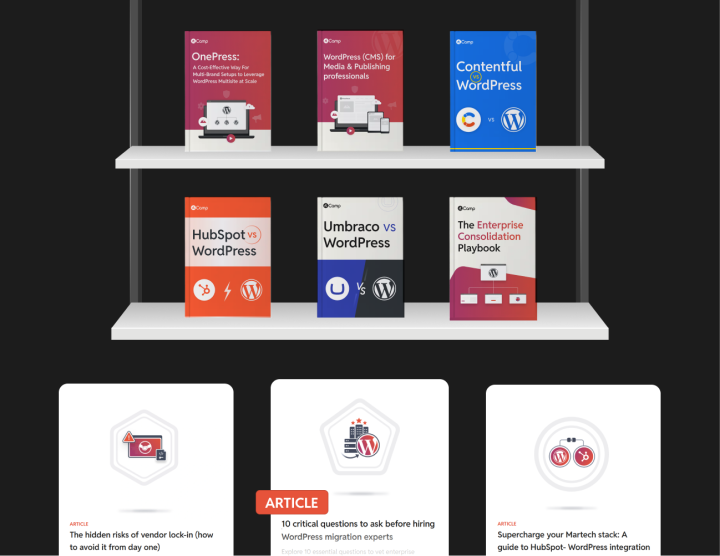Bringing automation to the WordPress DXP
As such, when you look at automation, you’re not looking at yet another DXP “solution” like a CMS or DAM.
Automation is more like a feature that a DXP’s different solutions bring with them.
For example, automation in the DXP CMS context would mean an editorial workflow that automatically triggers an email to the editor when the writer sends content for approval.
You get the drift.
Let’s first look at the ways enterprises can add automation to their DXPs before seeing how WordPress offers a better approach to automations than your typical proprietary DXP.
How enterprises implement automation in DXPs
Enterprises leverage a combination of native automation, third-party solutions, and API-driven workflows to create a seamless experience. Here’s how they approach it:
1. Built-in automation engines
Some proprietary DXPs include automation engines, but these are often limited in scope. Enterprises usually still require third-party automation solutions for more complex workflows.
2. Marketing automation platforms
If you use a marketing automation solution like HubSpot in your DXP, then the marketing automation solution helps automate lead nurturing, campaign execution, and audience segmentation.
3. Sales automation platforms
If you’re integrating a sales automation platform like, say, Pipedrive, with your DXP, then it will bring automation to your sales journeys, ensuring that leads are managed efficiently through automated workflows.
Beyond these, your personalization solution will bring rule-based or AI-driven automated personalizations to your DXP mix.
4. Low-code/No-code automation tools
Platforms like Zapier, Make (Integromat), and n8n also allow you to automate workflows without heavy development.
5. API-first automation
Finally, by tapping REST APIs and webhooks, you can trigger automation workflows across all your systems.
Before we explore how WordPress offers a better approach to automation compared to proprietary DXPs, let’s first take a look at what typical automation looks like for enterprises.
Automation capabilities enterprises typically implement
You may use DXPs to implement various forms of automation, including:
1. Content & editorial workflow automation
- Dynamic content publishing – Automatically updating content across different channels. This could extend to content distribution too with your email service using your blog content to automatically populate and schedule emails.
- Approval workflows – Notifying editors and stakeholders when content moves through different stages.
- SEO & AI content optimization – Using AI to enhance readability, keyword optimization, and search rankings.
2. Marketing & customer engagement automation
- Lead nurturing & scoring – Categorizing and engaging leads based on behavior.
- Behavior-based triggers – Delivering personalized CTAs, offers, and messages.
- Social media automation – Scheduling and posting across platforms.
- Campaign analytics & optimization – AI-driven insights to refine strategies.
3. Sales & customer journey automation
- CRM integration & lead routing – Assigning leads based on location, behavior, or other criteria.
- Automated chatbots & AI-driven support – Handling FAQs, bookings, and customer queries.
- Personalized customer journeys – Automating onboarding, follow-ups, and engagement sequences.
4. Backend & operations automation
- Data synchronization – Ensuring seamless data exchange between CRM, ERP, and marketing tools.
- Security & compliance monitoring – Automating GDPR, HIPAA, and governance processes.
- Performance monitoring & auto-scaling – Optimizing uptime, load balancing, and site performance.
Among others.
While proprietary DXPs offer automation capabilities, they often come with limitations in scalability, flexibility, and cost-effectiveness. Let’s now dive into why WordPress offers a better approach to automations compared to proprietary DXPs.
Why WordPress offers a better approach to automations compared to proprietary DXPs
Here’s how WordPress compares with proprietary DXPs when it comes to automation capabilities.
Automation setup
Proprietary DXPs typically offer pre-packaged automation solutions that are rigid and often require additional licensing fees for each automation feature. Customizing these automations usually involves a lot of vendor-specific coding and extra development work.
WordPress, on the other hand, provides a flexible automation layer where you can integrate tools like Zapier or build custom API workflows. Whether you need to automate content publishing, sales lead nurturing, or backend processes, WordPress supports it without the need for complex custom development.
Scaling automation
With proprietary DXPs, scaling automation often means incurring higher licensing costs and dealing with vendor limitations. If your needs evolve, you may face significant additional costs or restrictions imposed by the vendor’s ecosystem.
WordPress, in contrast, enables scalable automation with a pay-as-you-go model. You can scale automation capabilities organically, adding integrations as needed without being locked into an expensive, rigid structure.
Integration model
Proprietary DXPs often come with a closed vendor ecosystem, meaning that most of their automation solutions are designed to work only with other tools from the same vendor. This limits flexibility and increases costs for integrating third-party solutions.
In contrast, WordPress, as an open-source platform, WordPress supports unlimited third-party integrations. Whether you want to integrate a CRM, DAM, or AI tool, WordPress’s API-first architecture makes it easy to connect with whatever tools best suit your enterprise’s needs. This reflects in its approach to automations across these solutions as well.
Final thoughts
WordPress as a DXP delivers outstanding automation through its integration friendliness, customizability, and interoperability. Unlike proprietary systems that force predefined workflows, WordPress empowers you to build tailored automation solutions—without high licensing fees or vendor lock-in.
This means you enjoy a cost-effective, scalable, and future-proof automation ecosystem that evolves with your business needs.







